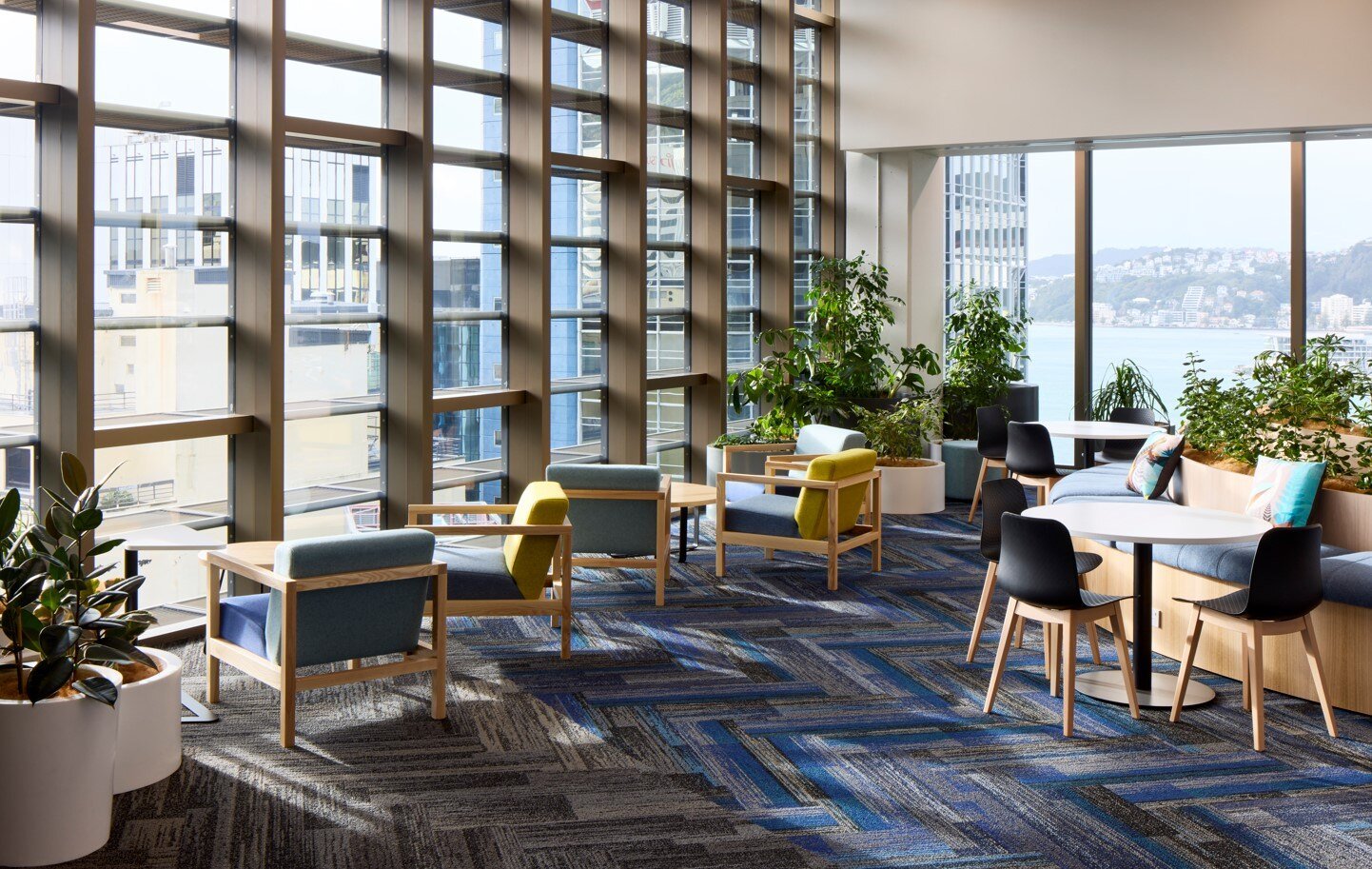From defunct to dynamic - 8 Willis Street is a world-class act in regeneration.
It is Wellington’s first 6 Green Star built rated commercial building.
Essentials
Name: 8 Willis
What: redeveloped 12 level building; 13,300 square metres; existing 1980s building 7 level structure retained; five new floors; cantilevered form integrated at level 5
Location: Lambton Quay and Willis Street intersection
Tenants: Statistics NZ Tatauranga Aotearoa; Ministry for the Environment Manatū Mō Te Taiao
Daily occupancy: 700 people
Address: 8 Willis Street, Wellington Te Whanganui-a-Tara
Project Snapshot
Owner: Argosy Property Ltd
Architect: architecture +
Main contractor: McKee Fehl Contractors
GSAP: Patrick Arnold, 335 Ltd
Building services engineer: Cora/Benmax
Structural engineer: Beca
Project timeline: design process 2018; construction April 2019; completion (Covid disrupted) and occupation May 2022
Project certification: 6 Green Star – Office Built v3 rating (2023); 5.5 star NABERSNZ base building rating (2023)

On a scale of outstanding, complex, green projects 8 Willis Street hits the high notes.
Purchased by Argosy 30 years ago this 1980s property once ranked as a quality offering centre stage in the capital’s CBD.
But over the decades the building slipped to low B-grade status with poor natural light, a low seismic rating, inefficient air-conditioning and second-rate amenities.
Armed with its steadfast commitment to sustainability and living and building green, Argosy made the decision to repurpose the building in 2018.
Green Star rated buildings have an increasing presence in Argosy’s portfolio - using the tool was a natural fit and an aspiration also shared by its tenants.
“We completed a due diligence exercise and reuse of the building structure provided a lower embodied carbon solution than demolishing the whole structure and rebuilding anew. Furthermore this approach had a lower risk profile, reducing the ground and foundation works associated with a demolish and rebuild,” says Argosy head of sustainability, Saatyesh Bhana.

As a starting point thousands of tonnes of concrete were retained in situ providing a serious sustainability dividend.
An LCA analysis to quantify the environmental benefit of repurposing 8 Willis Street calculated savings of around over 2000 tonnes of carbon.
But the project was no easy win.
A raft of complexities posed challenges – a geographically tight site, limited truck access, one of the highest pedestrian counts in the CBD and the application of heating and cooling technology.
The 8 Willis Street assignment was sophisticated and vast in scope.
While the original 1980s tower block was redeveloped, its floor area was increased by expanding the building upwards and outwards into the airspace above Argosy’s adjacent project – its sensitive and sustainable redevelopment of the much-loved Wellington landmark Stewart Dawson’s Corner.
The new cantilevered form at 8 Willis Street, hovering above its heritage neighbour, allowed utilisation of landlocked areas of the site.
Architecture + project lead, Stephen Poulopoulos says the project design was shaped by “strong motivation from Argosy to deliver an environmentally-positive outcome.”
He says the architecture language of the new building has been broken down into two connected tower forms which use similar but differing glazing/cladding details and colour tones to complement the streetscape and public realm on the one hand yet not overwhelm the heritage neighbour on the other.

Its design vocabulary features:
- the pushing in and out and rhythm of the new glazed façade to reflects the depth and shadow of the adjacent heritage buildings
- the transparency of the selected high-performance glass allows the external observer to see activity inside the building – providing a sense of humanity often lost with the use of reflective glass
- the elimination (largely) of building parapets - giving the impression of glazing extending effortlessly into the sky
A big fan of building reuse Project GSAP, Patrick Arnold says 8 Willis Street spells out the huge potential to regenerate tired buildings from the past.
“Even without considering its environmental accreditation, walking around the building today it’s been opened up across the floors, at the façade and atriums. It’s just an incredibly nice building to be in.”
His project highlights include thermally broken window joinery (unusual for a commercial office building), and an innovative rooftop solar hot water system using heat pump technology (reducing greenhouse gas emissions). “Winning a 6-star built rating without having gone through a design rating first – is pretty unique in the industry, I think”
The project scored 10 out of 10 for innovation.
Saatyesh Bhana says new strategies for decarbonisation, seismic resilience, sustainability and occupancy wellness were on the project short list.
“Green Star prescribes a criteria to design and build to – and a framework of elemental features for minimising the carbon footprint of a build.”
“We took an inventive approach to applying technology and this contributed to our Green Star rating. Utilising the experience of our design build team, taking those calculated risks and seeing ‘it work’ makes you smile.”

McKee Fehl Construction services project manager, Hendrik Prins says 8 Willis Street has been a complex design and build contract which has utilised state of the art methodologies to “deliver a stunning product.”
“This project presents an example of ways where old, existing buildings in the Wellington region can be reused and strengthened to create a world-class space.”
- reuse of the structure of the previous building
- building energy input is 100 percent electric
- thermally broken curtainwall system using argon-filled double glazed units (with improved airtightness detailing)
- thermodynamic solar water heating
- photovoltaic panels
- water efficient fittings and recycled rainwater, greatly reducing overall water consumption
- chilled beams used for heating and cooling - high-quality thermal environment
- maximisation of natural light
- EOT facilities positively integrated into building
- lower environmental impact concrete and steel
- no new carparks
- solar heat pump hot water scheme
- material lifecycle impacts
- market transformation – Green Bonds (Argosy)
Green Star: anchor tenant Statistics NZ’s fitout at 8 Willis Street achieved a 6 Green Star interiors v3 rating (2023)
